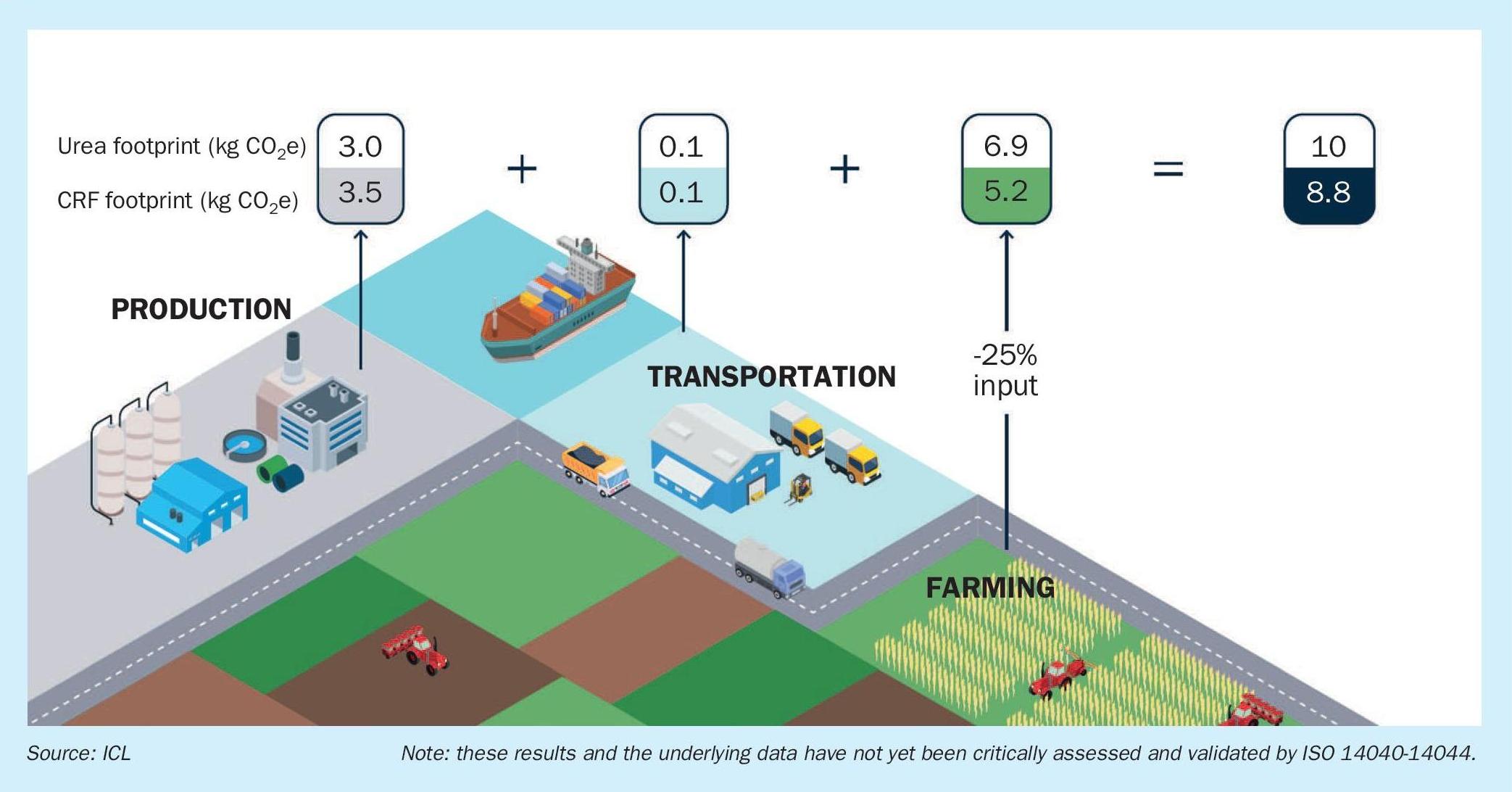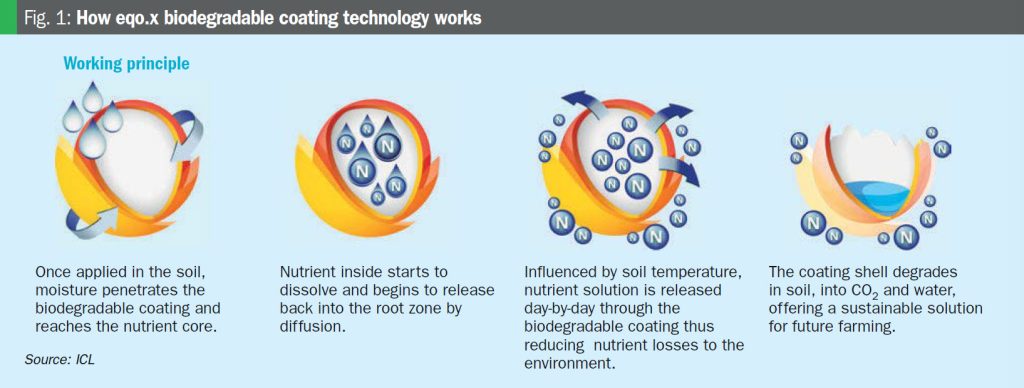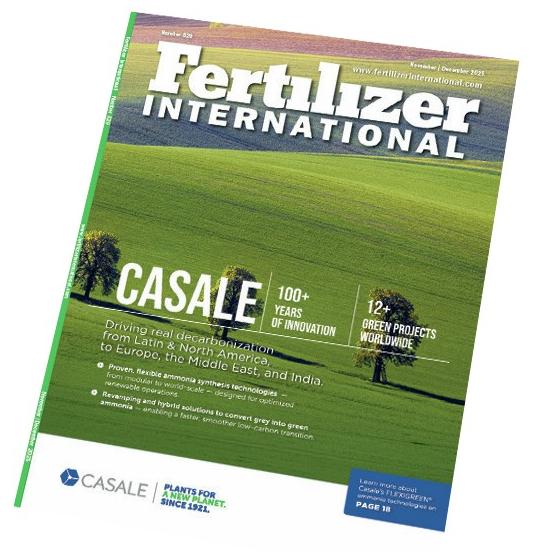Fertilizer International 522 Sept-Oct 2024

30 September 2024
Controlled-release fertilizers for sustainable farming
INTERVIEW
Controlled-release fertilizers for sustainable farming
Ronald Clemens, ICL’s Marketing & Portfolio Manager CRF, talks to Fertilizer International about the role of controlled-release fertilizers in sustainable agriculture.
Introduction
A controlled-release fertilizer (CRF) – as defined by ISO Standard 8157:2022 – is a: “fertilizer in which nutrient release is controlled, meeting the stated release rate of [the] nutrient and [meeting] the stated release time at a specified temperature.”
CRFs are coated products that essentially function by encapsulating fertilizer granules within a membrane. The release of nutrients through this membrane into the soil is consistent and predictable and largely regulated by soil temperature. CRFs offer the following agricultural benefits for field-grown crops:
- Fewer fertilizer applications
- Less impact on soil pH and salt levels in soils
- Positive effects on soil microflora
- Cut nutrient losses to the environment by up to 50 percent
- Increase nutrient use efficiency (NUE) by up to 80 percent
- Provide higher or similar crop yields at the same or reduced fertilizer application rates, respectively
- Reduce the carbon footprint of fertilizers at farm level by up to 10-12 percent.

ICL has developed a new generation of biodegradable coatings for its CRF portfolio (Fertilizer International 510, p24). The new coating technology is designed to meet the requirements of the EU fertilising products regulation (2019/1009) and reduce the environmental footprint of CRFs.
This patented innovation – named eqo.x – coats nitrogen fertilizer granules applied to crops. The new coating has been fully tested in the field and shown excellent results in terms of ease of production, higher NUE, and lower volatilisation and leaching losses.
ICL has now started to incorporate eqo.x in its well-established and market-leading Agrocote and Agromaster CRF formulations. How this biodegradable coating functions is shown in Figure 1.
“The mechanism of nutrient release from CRFs depends on the type of coating, but generally it is a very similar combination of diffusion with osmotic pressure,” explains Ronald Clemens. “As soon as granules are applied to the soil, water will penetrate through the coating by diffusion and the nutrients will start to dissolve. Osmotic pressure will then slowly press nutrients out of the coating.”
“The coating really needs to work as a membrane, as a kind of raincoat around the granule, for this specific mechanism to work,” he adds. “As well as being consistent and predictable, to have high efficiency, the longevity of nutrient release also need to be a good fit for and match crop demand.”
The contribution that CRFs can make to sustainable farming has three main aspects, says Clemens:
- Higher NUE and reduction in nitrogen losses
- Lower carbon footprint at farm level
- Support for plant-growth promoting micro-organisms (PGPMs).
“First, controlled-release fertilizers are seen as enhanced efficiency fertilizers with the ability to reduce nitrogen losses – and we have some new results to share on this. Second, how do you look at the carbon footprint of controlled-release fertilizers, not just from a production perspective but actually over the whole life cycle of their use? Last but not least – and this is a relatively new topic – how can CRFs also support healthy soils? As a company, this is a question ICL often gets asked by its customers and recently there is clear proof that CRFs can indeed contribute to soil health,” comments Clemens.
Improving NUE and reducing nitrogen losses
There is convincing evidence that CRFs are very effective in reducing nitrogen losses from all pathways. For example, a recent paper in Nature Food concluded that CRFs avoided nitrogen losses from three different pathways – runoff/leaching, nitrous oxide emissions and ammonia volatilisation – based on a meta-analysis of 21 previous studies1 .
“This relatively recent publication by University of Melbourne researchers is based on a meta-analysis done across the globe comparing standard urea applications with different types of enhanced efficiency fertilizer (EEF), including urease inhibitors, nitrification inhibitors and controlled-release fertilizers. CRFs were actually the only EEF shown to be very effective at reducing nitrogen losses for all the possible pathways – ammonia volatilisation, leaching or N2 O emissions,” comments Clemens.
ICL has also been commissioning research in Hungary and Germany over the last two years. This is assessing nitrogen losses via ammonia volatilisation and denitrification in both the field and under controlled conditions. These trials are comparing the performance of conventional urea versus controlled-release urea (eqo.x) and stabilised urea (urease inhibitors).
Carbon footprint reduction at farm level
A complete life cycle analysis is necessary to fully understand and calculate the carbon footprint of fertilizers, as production footprints alone are only part of the picture and can therefore be misleading. The carbon footprint for the production of coated urea (3.5 kg CO2 eq/kg N), for example, is higher than that of standard commodity urea (3 kg CO2 eq/kg N), although slightly lower than that of calcium ammonium nitrate (3.6 kg CO2 eq/kg N).
However, the higher NUE of CRFs, plus their lower nitrogen losses, pro-vides scope for creating a lower overall carbon footprint for fertilizer inputs, when this is measured over the whole life cycle. This is achieved by delivering the same crop yields at reduced nutrient input levels and correspondingly lower fertilizer application rates.
Indeed, ICL believes that by substituting CRFs for standard commodity urea it should possible to reduce the on-farm use of nitrogen fertilizers by around 25 percent. By reducing the contribution at farm-level (from 6.9 to 5.2 CO2 eq/kg N), CRFs can cut the overall life cycle carbon footprint of urea use from 10 CO2 eq/kg N to 8.8 CO2 eq/kg N (Figure 2).

“This is where enhanced efficiency fertilizers like CRFs can really deliver an improvement. For instance, by making it possible to reduce inputs by 20-30 percent – or keep inputs the same and increase crop yields – reductions in the carbon footprint of 10-15 percent are possible over the total life cycle,” comments Clemens.
Microbes and soil health
The effects of fertilizers on soil health are generally portrayed as negative. But is this perception warranted?
“Can controlled-release fertilizers actually have positive effects on soil health? In general, when we speak about mineral fertilizers, people have a negative view on what it does to microbial life and soil health. But is that always the case?,” asks Clemens
For example, in 2023, Shangdong Agricultural University, China, published the findings2 of a long-term study on the effect of CRFs on plant-growth promoting micro-organisms (PGPMs). In this 12-year study, wheat-maize rotation lysimeter experiments were carried out over 24 seasons between 2009-2021. These investigated the effects of CRFs on the function and composition of soil microbial communities. Products used included polymer coated urea (PCU), sulphur coated urea (SCU) and, by a combining the two coatings, polymer sulphur coated urea (PSCU). The Chinese researchers concluded that:
1. The use of CRFs increased soil organic matter (SOM) content by 3.1-5.0 percent compared to conventional urea.
2. SCU and PSCU, versus PCU, were better at stimulating the growth of PGPMs while inhibiting the growth of nitro and denitrifying bacteria and plant pathogens. This promoted better wheat yields, reduced nitrogen losses and helped prevent plant disease.
3. SCU and PSCU, by significantly increasing SOM and therefore providing more substrate for the growth of PGPMs, increased wheat yield.
“The important conclusions were, first of all, that controlled-release fertilizers were able to increase soil organic matter. The sulphur coated urea (SCU) and polymer sulphur coated urea (PSCU) clearly had benefits in stimulating plant growth and promoting micro-organisms, while, on the other hand, inhibiting the growth of nitro and denitrifying bacteria and also reducing plant pathogens,” comments Clemens.
CRFs have also been shown to have positive effects on the biological control of bacterial plant diseases, as confirmed by recent research at Wageningen University in the Netherlands. CRFs tested on flowering plants (Pelargonium) showed a positive effect on the microbiome – with an increase in bacterial antagonisms and a decrease in plant pathogens. The researchers concluded that:
- An abundant direct nitrogen supply can raise plant sensitivity to bacterial diseases
- The type and dose of mineral fertilizer can have an effect on the microbiome of the fylosphere
- Applying CRFs in combination with the micro-organism Bacillus amyloliquefaciens had a positive effect on plants.
“This recent study on ornamental plants in the Netherlands, which ICL contributed to, showed that controlled-release fertilizers have a positive effect on the biological control of certain bacterial plant diseases. The main conclusion was that abundant direct nitrogen supply resulted in a higher sensitivity of plants to disease – and that the type fertilizers and their applied dose really has an effect on the success of flower growing,” commented Clemens.
“With controlled release fertilizers, nitrogen is applied day-by-day in small quantities. CRFs had positive effects on flowering plants, by lowering sensitivity to bacterial diseases, for example, and when used in combination with plant-applied micro-organisms,” he added.
In summary, ICL believes CRFs can have a positive effect on soil microbiota in the following ways:
- Higher NUE can result in higher yields, more crop residues and increased soil organic matter
- Controlled release of nitrogen, versus high nitrogen availability, can positively influence the microbiome
- Coating sources like sulphur can have a positive effect on PGPMs and depress denitrifying bacteria and plant pathogens
- This raises the option of developing hybrid coated/biostimulant fertilizer products that combine CRFs and beneficial micro-organisms.
“Coatings based on sulphur, for instance, can certainly have a positive effect by depressing plant pathogens. I think there are also real opportunities for developing combinations of controlled-release fertilizers and certain biostimulants based on micro-organisms to improve fertilization efficiency,” concludes Clemens.
Acknowledgement
This article and conversation is based on a presentation How can controlled-release fertilizers support sustainable farming? delivered by Ronald Clemens at Informa’s New AG International Annual conference, Berlin, 9-11 April 2024.
References







